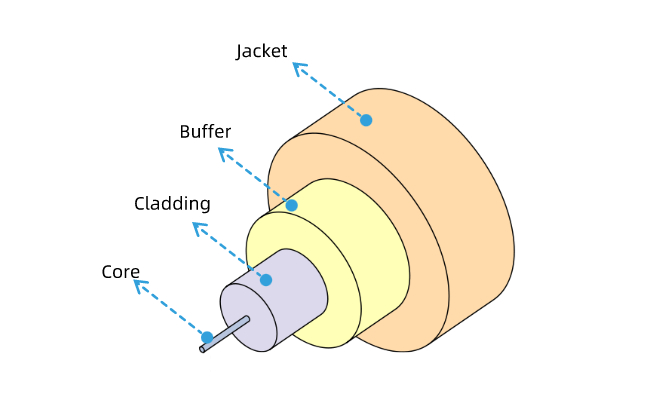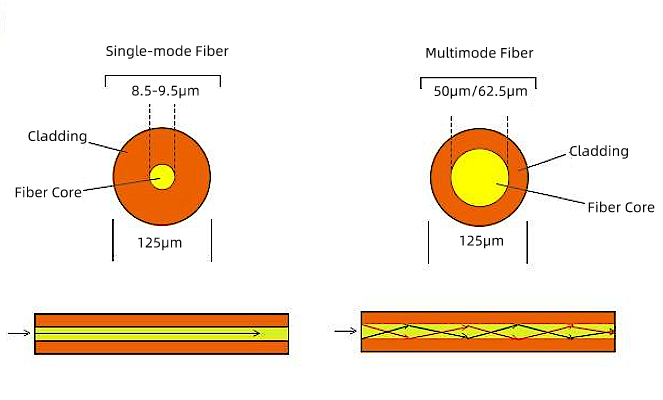Fiber vs Copper: Advantages and Disadvantages
What is Optical Fiber?
Optical fiber, also known as fiber optic cable or fiber optics, is generally composed of the fiber core, cladding layer, buffer, jacket, and fiber optical connectors. Since the loss of light transmitting through the optical fiber is much lower than electricity transmitting through the copper cable, fiber optic cable is typically used in long-haul transmission.

Optical Fiber Structure
Fiber core - Made of glass or plastic material and used to guide the light. There are three most common fiber core sizes, 62.5 μm diameter (multimode fiber OM1, OM2), 50 μm diameter (OM3, OM4, OM5), and 9 μm diameter (single-mode fiber).
Cladding layer - Covering the fiber core with a lower refractive index glass envelope. It is designed to reduce the loss caused by surface irregularities of the glass fiber core.
Buffer - Offering mechanical isolation and protecting the fiber from physical damage by encapsulating the fibers.
Jacket - The outermost layer of the fiber optic cable, providing optical fibers from environmental damage. Besides, different colors of jackets can be used for cable identification.
Color Coding of Optical Fiber Jacket
Types of Optical Fiber
There are two most common types of optical fiber, multimode optical fiber and single-mode optical fiber.
Single-mode Optical Fiber
Single-mode optical fiber, as the name implies, carries only a single mode of light. With a very thin core of 9 μm and not limited by modal dispersion, single-mode fiber allows higher fidelity when light is transmitted through the fiber, thus resulting in a higher bandwidth than multimode fiber. Therefore, single-mode fiber is usually applied in long-distance communication.
Multimode Optical Fiber
Contrary to single-mode fiber, multimode optical fiber enables hundreds of light modes with a thicker fiber core of 50 μm or 62.5 μm. Besides, it is limited by model dispersion while single-mode fiber is not. Hence multimode fiber supports limited bandwidth and distance compared to single-mode fiber. Despite the disadvantages of bandwidth and supported distance, multimode fiber has the benefits of larger core size and is easily connected to a light source like LED, also cost-saving. That's why multimode fiber is popular in short-distance communication.

Optical Fiber Types of Single-mode fiber vs Multimode Fiber
Advantages of Optical Fibers Over Copper Cable
It is known that fiber optic cable was introduced to make up for the bandwidth and distance limits of copper cables. However, the advantages of fiber optic cable are far more than bandwidth and distance. Why is fiber better than copper? This post will explain the benefits of fiber optic cables to you at length.
Infinite Bandwidth
Bandwidth is the rigid demand for data centers. As mentioned above, single-mode fiber is not limited by modal dispersion with a very small core size, hence the bandwidth of single-mode fiber is infinite in theory. As for multimode fiber, the most widely used OM3 multimode fiber has a bandwidth requirement of more than 2000 MHz-km, and OM4 multimode fiber requires at least 4700 MHz-km. When it comes to copper cable, the newest Cat8 copper cable supports a bandwidth of 2000 MHz-km. Therefore, both single-mode fiber and multimode fiber get a much more superior bandwidth than traditional copper cable.
Longer Distance
The higher the bandwidth, the longer the distance. For 40/100 Ethernet, OM4 multimode optical cable supports a link length up to 150meters, and the single-mode fiber even allows 80km distance communication, whereas Cat8 copper cable only allows a limited distance of 30 meters according to the 40GBase-T standard. However, most backbone link distances of data centers is more than 30 meters, so optical fibers have basically replaced copper cables in backbone links.
Faster Speed
Why does fiber have a faster speed than copper cable? It is mainly determined by the transmission principle of the fiber and copper cable. For optical fiber, it transmits data by modulating the analog signals into optical signals, then the lights are guided based on the principle of total reflection of light. Different optical signals do not interfere with each other. As for copper cable, it transmits data relying on electrical signals, and there is interference between electrical signals. That's why fiber optic has the advantage of speed over copper cable.
In practical application, according to IEEE 802.3bs standard, fiber has proved to enable 200/400G Ethernet. However, the newest Cat8 copper cable only supports 40GBASE-T at a limited transmission distance of 30 meters.
Thinner and Lighter Weight
Compared to copper cables, optical cables have a much smaller fiber core size, the multimode fiber core is about 50 to 62.5 μm, the single-mode fiber is even smaller up to 9 μm, whereas the diameter of a standard coaxial copper cable up to around 47mm.
Besides, the material difference between copper cable and fiber optic cable is also a vital factor to the weight. Optical fiber is made by fiberglass while copper is made by metal, thus resulting in fiber being lighter than copper cable. The characteristics of thin and lightweight make the fiber more convenient and easier to install.
Strong Anti-interference Ability
Quartz is the basic component of optical fiber, which only transmits light, neither conducts electricity nor is affected by the electromagnetic field, hence optical fiber enables a strong ability against EMI (Electromagnetic Interference) and power interference. And that's exactly why the signal transmitted in the optical fiber is not easy to be bugged. So optical cables have the advantages of stability and security over copper cables.
Higher Reliability
It is known that the reliability of a system is essential to the number of devices consulting the system. The more devices, the greater the possibility of failure. An optical fiber system is simple, whereas a copper cable system usually uses many amplifiers. Besides, the optical fiber system also has the advantage of long life for use. Statistically speaking, a fiber system enables the time of failure-free operation up to half a million hours. Consequently, fiber optics enjoy higher reliability than copper wire.
Disadvantages of Optical Fibers Over Copper Cable
Nevertheless, there are advantages of copper wire over fiber optics:
Low Tensile Strength
The material of the fiber core is fiberglass, whereas the material of copper cable is copper. Fiberglass is more fragile than copper, hence the tensile strength of the fiber is lower than copper cable. Copper cable's high tensile strength is helpful in preventing cable stretching and breaking and thereby also helpful in preventing system failures.
Complex Fusion Process
The loss of fiber is associated with the fiber fusion process. Two fiber cores must be accurately connected. Since the fiber core is very thin and the melting point of quartz is high, it must be equipped with professional and fusion devices and technology.
Will Copper Cable be Replaced by Fiber?
Despite fiber optic cable having so many advantages over copper wire, copper cable still attracts consumers' favor due to its cost-effectivity in specific applications, such as traditional building cabling systems, LAN, PoE, KVM applications. On the whole, I think it is still far away for optical fibers to completely replace copper wire systems.
However, fiber is absolutely preferred over copper cabling when high bandwidth, long-distance, high speed, or immunity to EMI is required.
QSFPTEK provides high-quality fiber optic cables and copper cables, custom cabling solution is also available, welcome to consult via [email protected].











